Recently I realized that if I want to stay true to my promise, I need to collect those Hungarian recipes that characterize my everyday cooking and culinary heritage. Let’s start with a meat paprika stew called pörkölt. In my family, we don’t eat too much meat, but when I choose to cook meat, I often go with this, because it’s simple, delicious, and very easy to make.
Together with gulyás, paprikás, and tokány, it’s one of the four paprika dishes so typical for Hungarian cooking. The combination of fat, onions, and paprika results in an incredible harmony of flavors, and the aroma that fills our kitchen as I cook it – to use the expression I read in The Cooking of Vienna’s Empire by Joseph Wechsberg – “will not make you cry for peanut butter”.
Paprika – the word in Hungarian refers both to the spice and to the fresh vegetable – was introduced to Hungary in the end of the 16th century by the Turks, who occupied the country for 150 years. By the 19th century, it became the dominant spice for many tasty dishes, including pörkölt. Those of us who grew up with Hungarian cuisine don’t cook pörkölt from a cookbook – we learned the technique and the tricks from our mothers and grandmothers. However, if you are new to Hungarian cooking, I can assure you, there is nothing to be feared, pörkölt cannot be ruined. The main idea is that we fry the meat on high heat for a few minutes with the previously sautéed onions, then simmer it in its own juices very slowly. The quality of Hungarian paprika is also part of the success. There are cooks who stir the paprika with the sautéed onions immediately, add the meat, and then fry it; and there are those who first fry the meat on the sautéed onions, and sprinkle it with the paprika after that. I prefer the first method. Sometimes, at the beginning of the cooking or when we notice that some liquid has evaporated, a little water can be added to the dish, but the best method is to let the meat simmer entirely in its own juices. Instead of oil, of course we can sauté the onions in lard – some people believe that the paprika’s true redness shows the nicest in lard.
When cooking pörkölt, it’s a good idea to use more meat than called for in the recipe, because it has a long simmering time (beef needs more time than pork), it freezes well, plus it’s the basis for many Hungarian one-pot dishes or soups (for example the famous gulyás), so it’s nice to have some in the freezer ready to be used at any time. When cooking a bigger amount of meat, we actually save time and energy. Pörkölt is also tasty from veal, mutton, or venison, not just from beef or pork. Usually, we eat it with Hungarian spaetzle called nokedli, but it’s equally good with boiled potatoes, rice, or even cooked noodles. Fresh green salad, cucumber salad, or picked vegetables can also be served on the side.
beef shank or leg of pork – 1¾ lbs
olive oil – 2-3 tablespoons
medium onions – 2 (about 7 oz)
sweet Hungarian ground paprika – 1 tablespoon
tomato – 1
medium bell pepper – 1
salt – to taste
Cut the meat into 1-1½ -inch cubes, and finely chop the onions. Remove the seeds and ribs from the bell pepper, cut it into rounds, and cut the tomato into wedges. Heat the oil in a large cooking pot over medium heat, add the onions, and sauté, stirring occasionally, until soft and translucent, about 8-10 minutes. Take the pot off the heat, stir in the paprika until the onions are well coated, then add the meat. Put the pot back on the stove, set the heat high, and stir the meat continuously for about 2 minutes (searing the meat on high heat). Turn the heat to low. Season with salt, then add the tomato and the pepper. Cover the pot and simmer gently in its own juices for about 1½ – 2 hours, stirring occasionally. There should be very little liquid in the pot, so the meat fries in its own fat. While cooking, keep an eye on the dish – if you notice that the liquid has almost evaporated, add a little water. By the time the meat is soft, you should have a thick, almost creamy gravy under the meat. Enough for 4-6 people.
Note
The reason for removing the pot from the heat is that we don’t want to burn the paprika because it will taste bitter.
The pepper and the tomato can be put into the pörkölt whole, or alternatively, both can be chopped into small pieces. The tomato can be peeled and seeded if desired.
Mostanában tudatosítottam, hogy ígéretemhez híven végre össze kell gyűjtenem azokat a magyar ételrecepteket, amelyek mindennapi főzésemre, s egyben kulináris örökségemre jellemzőek. Kezdjük a pörkölttel. Általánosságban véve mi nem vagyunk nagy húsevők, de ha húsételt főzök, gyakran ezt választom, mert egyszerű, finom és nagyon könnyű elkészíteni. A pörkölt az egyik legnépszerűbb magyar ételünk, a gulyással, paprikással és tokánnyal egyetemben. A zsiradék, hagyma és pirospaprika kombinációja az ízek jellegzetes harmóniáját eredményezi, s főzéskor olyan aromával lengi be a konyhánkat, hogy ekkor nem vágyakozunk semmiféle más ételre (amerikai barátaimnak üzenem: még mogyoróvajas szendvicsre sem).
A pirospaprikát a 16. század végén a hódító törökök hozták be az országba, s a 19. századra több finom étel, többek között a pörkölt domináns fűszerévé lépett elő. Ha valaki magyar ételeken nőtt fel, nem szakácskönyvből főzi a pörköltet, mert elkészítésének csínyját-bínyját elleste édesanyjától vagy nagymamájától. Aki viszont csak most ismerkedik ezzel a konyhával, annak sincs félnivalója, mert a pörköltet talán nem is lehet elrontani. A lényeg az, hogy az olajon megfonnyasztott hagymán, erős tűzön néhány percig pirítjuk a húst, s utána a saját levében lassan pároljuk. A pörkölt sikeréhez nagyban hozzájárul a jó minőségű magyar paprika is. Van, aki ezt azonnal hozzákeveri a megfonnyasztott hagymához és utána teszi rá a húst, s van, aki először a húst pörköli meg a hagymán és később szórja rá a pirospaprikát. Én az első módszernek vagyok a híve. A hús alá kevés vizet is önthetünk még a párolás elején vagy ha elfőné a levét, de az a legjobb, ha teljes egészében a saját levében hagyjuk megpárolódni. Olaj helyett természetesen disznózsírt is használhatunk – azt mondják, ebben adja ki a pirospaprika az igazi piros színét.
Pörköltből megéri egy nagyobb adagot főzni, mert hosszú a párolási ideje (a marhahúsé hosszabb, mint a sertéshúsé), jól tűri a fagyasztást, ráadásul sok egytálétel és leves (pl. gulyásleves) alapját is képezi. Ezért jó, ha van egy kis tartalék a mélyhűtőben. Végül is időt és energiát takaríthatunk meg. A pörkölt borjúhúsból, birkahúsból, őzhúsból is finom. Leggyakrabban nokedlivel tálaljuk, de főtt krumplival, rizzsel, főtt tésztával is kitűnő. Friss zöldsaláta, uborkasaláta vagy ecetes savanyúság illik hozzá.
marhalábszár vagy sertéscomb – 800 g
olaj – 2-3 evőkanál
közepes fej hagyma – 2 (200 g)
pirospaprika – 1 evőkanál
paradicsom – 1
zöldpaprika – 1
só – ízlés szerint
A húst 2-3 cm-es kockákra, a hagymát finomra vágjuk. A zöldpaprikából kivágjuk az eret és a magházát, majd felkarikázzuk, a paradicsomot pedig cikkekre vágjuk. Egy lábasban az olajon üvegesre fonnyasztjuk a hagymát. Lehúzzuk a tűzről, megszórjuk pirospaprikával, jól elkeverjük és azonnal rádobjuk a húst. Visszatesszük a tűzre és nagy lángon, állandóan kevergetve, hirtelen (kb. 2 perc alatt) megpirítjuk. Mérsékeljük a tüzet. A húst ízlés szerint sózzuk, hozzátesszük a paradicsomot és a zöldpaprikát. Lefedjük és lassú tűzön, saját levében pároljuk. Ha elfőné a levét, egy kevéske vízzel pótoljuk. Mire elkészül az étel (másfél, két óra), sűrű, majdnem krémszerű mártás képződik a hús alatt. A recept 4-6 személyre szól.
Megjegyzés
A lábast azért vesszük le a tűzről, nehogy megégjen a paprika, mert akkor keserű lesz az étel.
A zöldpaprikát és a paradicsomot egészben is hozzáadhatjuk a húshoz, vagy mindkettőt kis kockákra vághatjuk, a paradicsomot meg is hámozhatjuk.

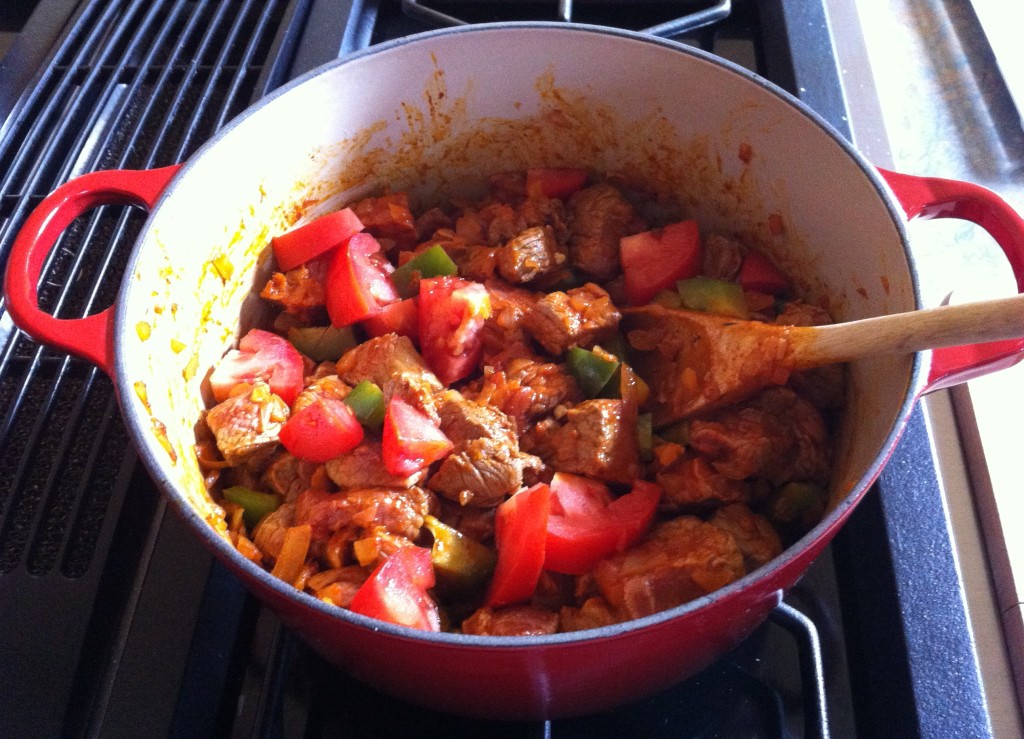
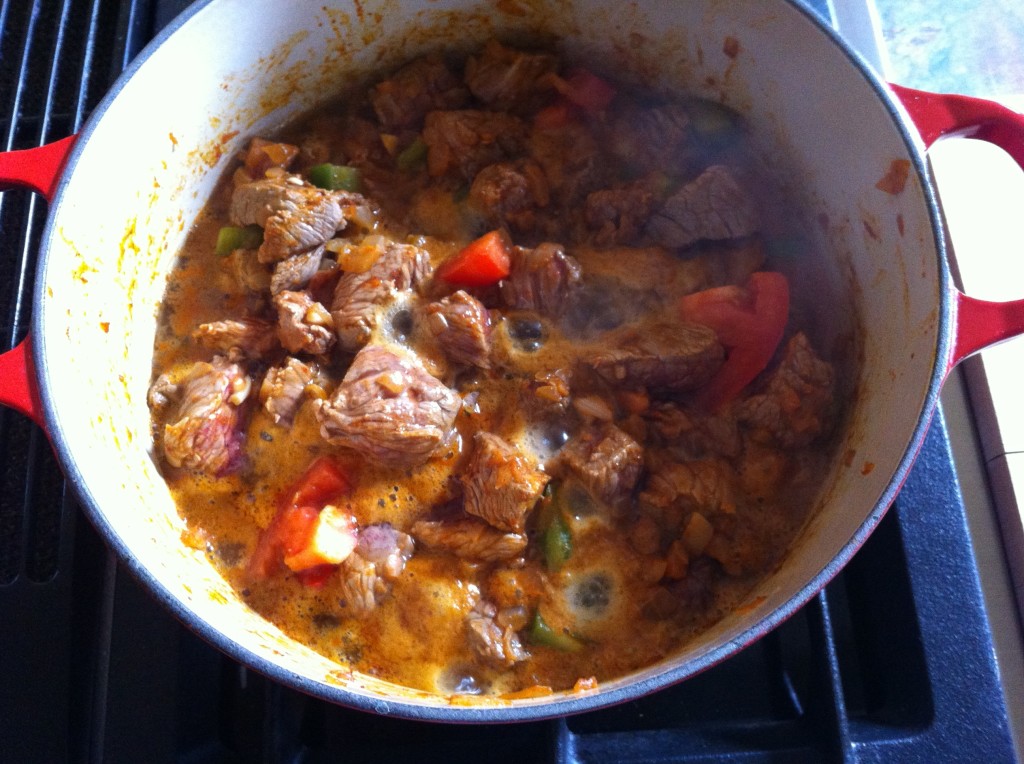
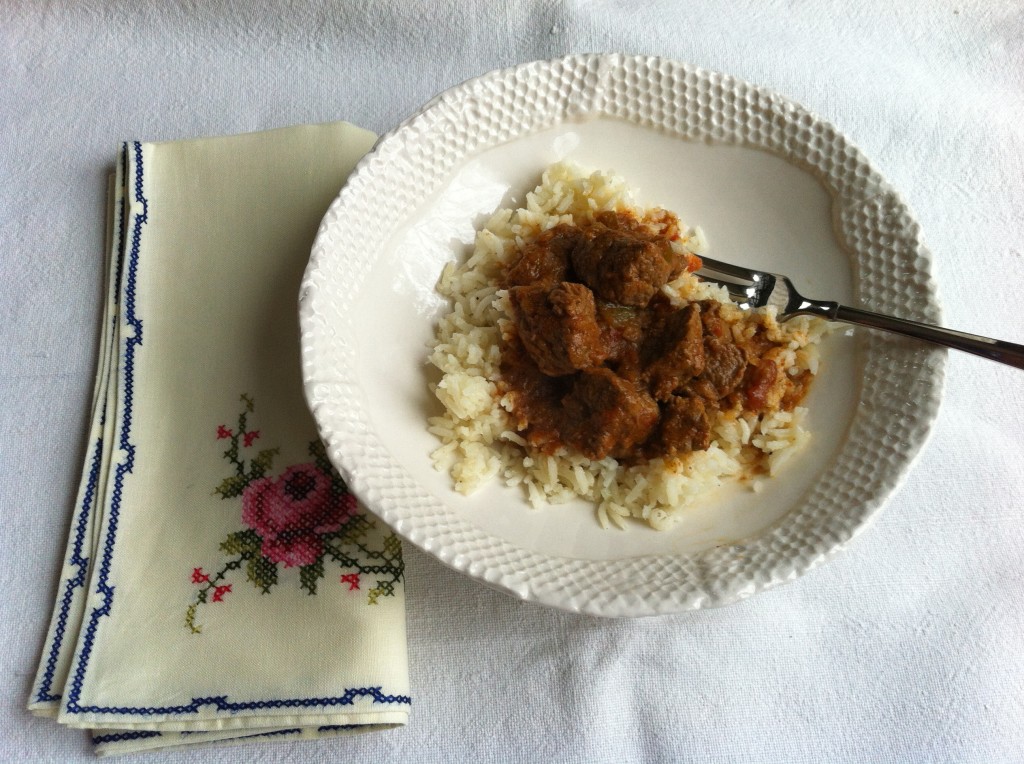
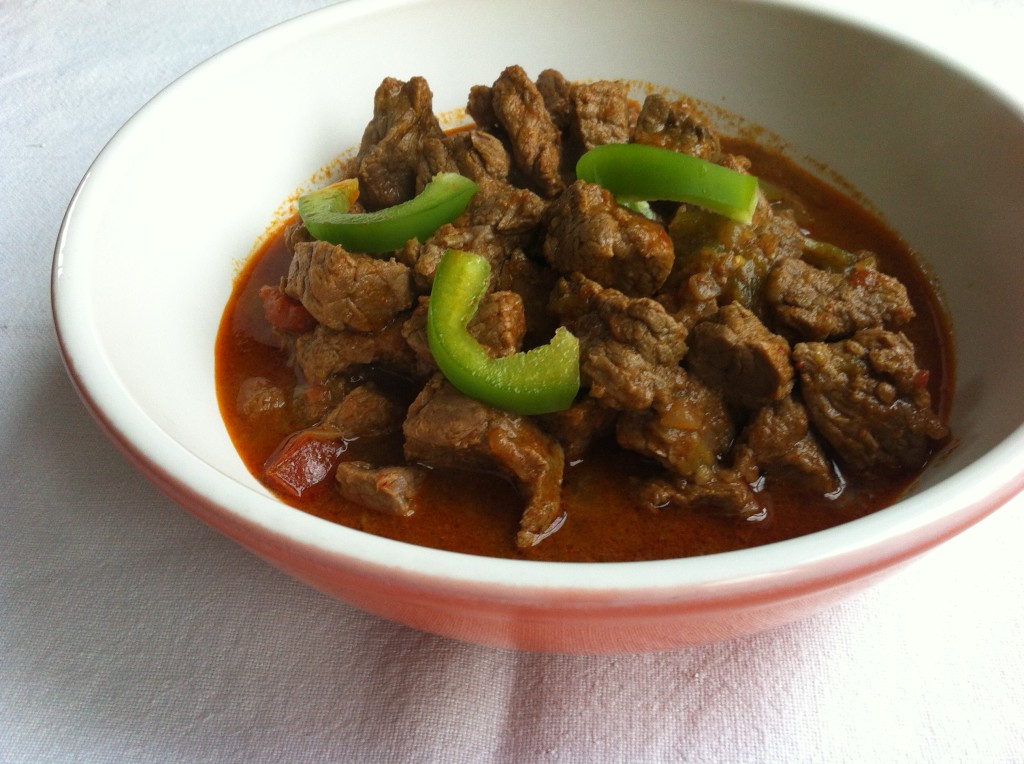
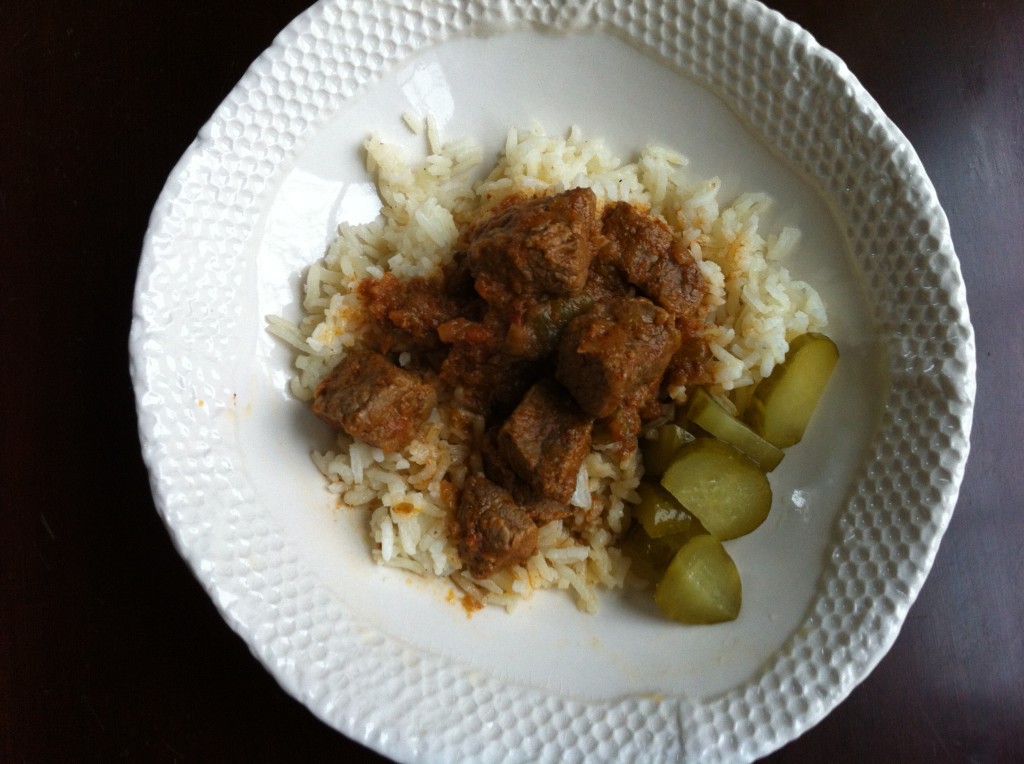





Looks delicious! Thanks for sharing. I can’t wait to make this.
I hope you can make it soon, Huyen. Please let me know how it turned out. And stay tuned for a gulyás (goulash) recipe.
I made this the other day and it was delicious with brown rice and a side salad. I heated it at work and someone commented how good it smelled. Thank you for sharing your recipe and Hungarian paprika to make this dish.